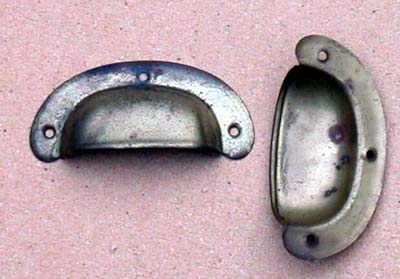ROLLER JIB FURLING
I have used a Wykeham Martin jib furler for many years, but
I am drawn to the conclusion that the ability to douse the fores’l
could be accomplished easily and cheaply with the use of a jib
downhaul. A light line, leading aft, attached to the peak of
the sail, and running down inside the jib hanks, would need
a fast pull with the sheet eased, and the jib is doused. This
presupposes that the hanks are big enough to accept the light
line.

FORMICA SHEET
When assembling a dagger board, or centreboard case, it would
be a good idea to glue in a few vertical strips of Formica sheet.
This would provide good bearing surfaces for the board, and
help to remove some of the risk of jamming.
I have heard also, that strips of Formica glued to the bottom
of a dinghy, give a nice slippery surface for when the boat
is dragged ashore. I have just acquired a 4ft by 3ft sheet of
grey Formica at the excellent price of £2.00 UK Pounds,
and this is much, much cheaper that strips of flat brass etc.

CABIN BULKHEAD VENTILATION
On a small cruiser, which I owned at one time, I bored two
1-inch holes, close together, at each side of the after bulkhead,
near the coachroof. I then screwed over each pair of holes,
one of those old half-round brass drawer pulls, bedded on soft
sealant. This gave the desired ventilation and was rain and
spray proof.


HOW TO REPAIR LEAKY FUEL TANKS
This topic has been aired on some of the Yahoo Boat Forums,
but I feel that it is useful. Small splits and holes are best
dealt with by brazing, if possible, rather than welding, especially
if the man doing the welding is not a professional. Bigger holes
should be patched and welded.
Folk wisdom suggests that the tank can be washed out with water
etc, or filled with sand. These methods should NOT be attempted
as they are very dangerous, and do not remove the petrol vapour.
The method I have used several times with absolute safety, is
to fill the tank with inert gas. The gas I used is Carbon Monoxide,
which is available for the price of a drop of fuel used in a
petrol (gasoline) engine.
I run a large bore hose, such as used by a vacuum cleaner,
from the exhaust pipe of a running petrol engine, and inserted
into the fuel tank awaiting repair. After half an hour or so,
you can plunge a lighted welding torch into the tank with no
harm. Then simply do the needed repair, apply some protective
paint after cooling, and remount the tank.
Please bear in mind that Carbon Monoxide is poisonous, used
on occasion by suicides, and also that a diesel engine does
not emit it. Diesel exhaust stinks, but it is not Carbon Monoxide.

NON-SLIP DECK PAINT
Instead of buying expensive non-slip deck paint, I have used
ordinary oil based paint, with sharp sand scattered onto it.
The method is as follows.
As the protection of paint is in direct ratio to its thickness,
it is necessary to apply several coats. As undercoat is cheaper
than gloss, and also easier to rub down, I use two or three
coats of undercoat. Whilst the last coat is wet I sprinkle the
sharp sand onto it. After the paint is dry, then the surplus
sand is brushed off, followed by two coats of gloss, without
any rubbing down. The sharp sand is obtained from Garage Suppliers,
and is used in spark-plug cleaners. Any fine dry sand would
do.

